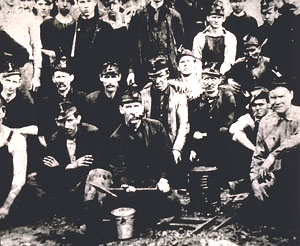
Roane County
Roane County is situated at the juncture of the Tennessee, Clinch, and Emory Rivers, a location of vital importance to both white settlers and Native Americans in the early years of Tennessee state history. Settlers gained control of the area through three treaties with the Cherokee Indians: the Treaty of 1794, the Third Tellico Treaty of 1805, and the Hiwassee Purchase made through the Calhoun Treaty of 1819. In 1792 John Sevier established Fort Southwest Point at the convergence of the Tennessee and Clinch Rivers to protect white settlers traveling west. Initially the fort was placed near a spring rather than at a higher point, since the defenders apparently valued access to water more than strategic advantage. In 1797, when the mission of the fort changed to one of offering protection to the Indians against the encroaching settlers, the fort was expanded and moved to a hill overlooking the two rivers. The boyhood dreams of Roane County Historian J. C. Parker were fulfilled posthumously in 1996 with the completion of the restoration of Fort Southwest Point and its dedication and opening to the public.
After several petitions to the state legislature, Roane County was established in 1801 and named in honor of the second governor of Tennessee, Archibald Roane. The town of Kingston, in the shadow of Fort Southwest Point, was chosen as the county seat. In 1807 Kingston became “Capital for a Day.” The Tellico Treaty of 1805 stated that Kingston would become the state capital in return for thousands of acres of Indian land. It did, for a few hours on September 21, 1807. The terms of the treaty were thus fulfilled, the capital was returned to Knoxville, and the Indian land was forfeited. A monument commemorating this infamous event stands in the center of Kingston.
It was not until the Civil War, when Union Colonel John Wilder led troops through the area, that the commercial potential of local mineral deposits was recognized. Wilder, with other northern industrialists, organized the Roane Iron Company, and in 1868 established the town of Rockwood. It was a “Company Town of the New South,” shipping pig iron first by steamboat and later by rail.
The town of Harriman brought diversified industry to Roane County late in the nineteenth century. Northern industrialists of the East Tennessee Land Company, impressed by the climate, location, transportation systems, and work ethic of southerners in the area, established the town of Harriman in 1890. The industrialists were strict prohibitionists with strong religious backgrounds and high ideals who believed that sober workers and a variety of industries would insure a successful town and reliable profits. In February 1890 the company held a “Great Land Sale” on its property. Thousands of buyers from all across the United States offered astonishing prices for lots. Within ten hours 573 lots had been sold for more that $600,000. Utopian dreams shaped this social experiment in town building. Every contract or deed contained a provision forbidding the use, making, storage, or selling of intoxicating beverages. As a result, Harriman soon gained the reputation as a “Utopia of Temperance.”
Oliver Springs, a small town at the convergence of the Roane, Anderson, and Morgan County lines, enjoyed national prominence as a mineral springs resort that attracted people from across the eastern United States in the late nineteenth century. Richard Oliver, the first postmaster of the town and the man for whom the town was named, commercialized the springs. Oliver built a four-story hotel containing almost two hundred rooms topped by a sixty-foot tower. The resort featured bridle paths to the top of Walden’s Ridge, a billiard room, electric elevators, wine cellars, and a dance pavilion. The resort burned in 1905 and was not rebuilt.
Roane County has its share of famous residents. Return Jonathan Meigs served as Indian agent at Fort Southwest Point. Sam Houston lived in Kingston briefly, where he clerked in a store before volunteering for military service in the War of 1812. A little known Civil War heroine was sixteen-year-old Mary Love, who carried a Union message to Knoxville through Confederate lines. Sam Rayburn, longtime Speaker of the U.S. House of Representatives, was born in Roane County in 1882 and lived there until 1887, when his family moved to Texas. Roane County also has its infamous residents. Cherokee chiefs Tullentusky (variously spelled) and Doublehead attacked local settlements for several years. The Harpe brothers swept through Roane County in the early 1800s, killing and pillaging.
Today, Roane County offers the tranquil beauty of Watts Bar Lake, the community atmosphere of small town living, and the convenience of proximity to the metropolitan areas of Knoxville and Chattanooga. Its 2000 population was 51,910.



